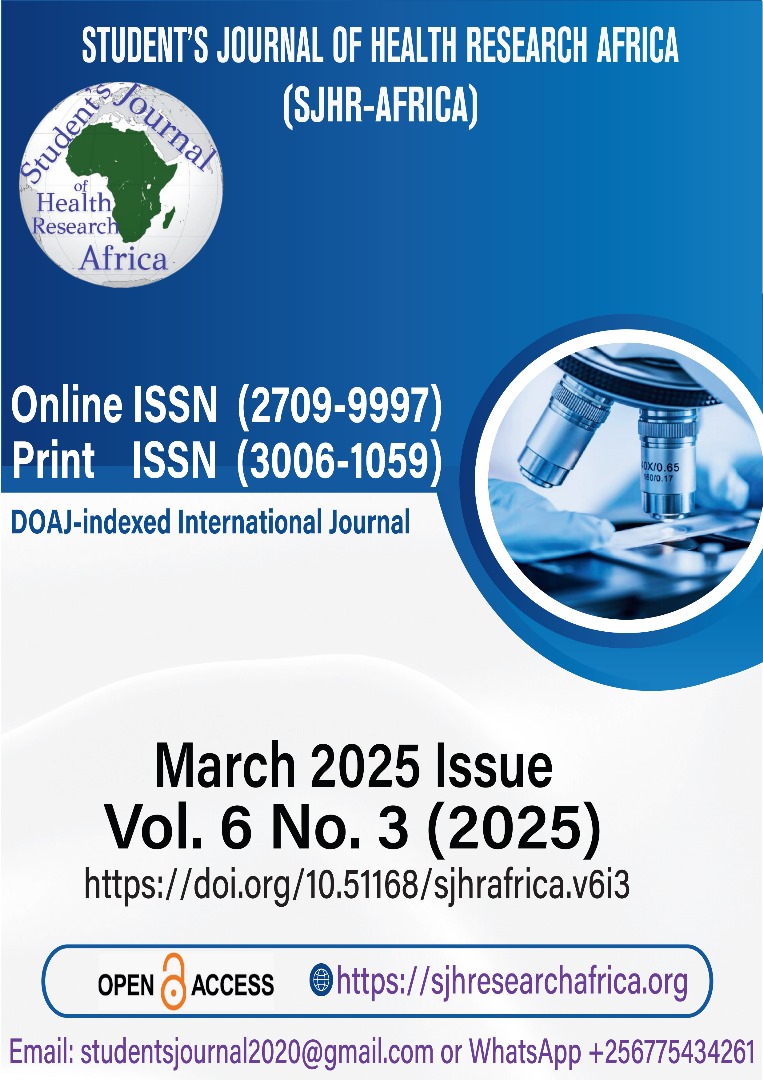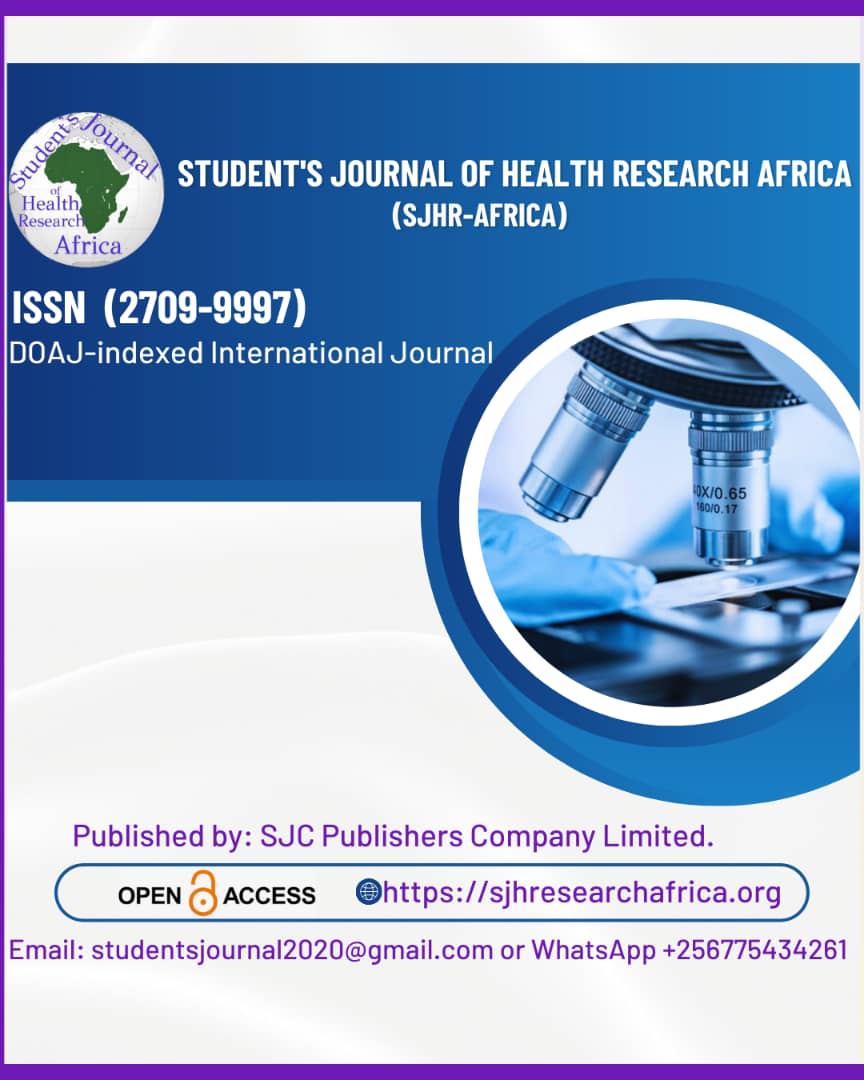SEROPREVALENCE OF TTI AMONG BLOOD DONORS AT THE BLOOD CENTER, LALITPUR: A RETROSPECTIVE CROSS-SECTIONAL STUDY
DOI:
https://doi.org/10.51168/sjhrafrica.v6i3.1653Keywords:
Prevalence, Transfusion-transmitted Infections, Blood Centre, Blood Donor, HIVAbstract
Background
Millions of lives are saved by timely, safe, and enough transfusions; yet inappropriate transfusions raise the risk of transfusion-transmitted infections (TTIs) and cause numerous potentially fatal consequences. All infections that can spread from person to person by parenterally administering blood or blood products are known as TTIs.
Objectives
At a blood center at Autonomous State Medical College (ASMC), Lalitpur, Uttar Pradesh, the study sought to ascertain the TTI prevalence in both replacement and voluntary donors.
Materials and Methods
Data that were collected on donors of blood collected at a blood center between 2021 and 2024 was the subject of retrospective descriptive research. Data that were extracted from the database included age, sex, and donation type. The outcomes were total TTI, syphilis seropositivity, HIV, HBV, and HCV.
Results
The sociodemographic analysis revealed a predominantly male donor population (95.6%) with a mean age of 43.9±7.3 years, and the majority were family donors (81%). The overall seroprevalence of transfusion-transmitted infections (TTIs) was low, with Hepatitis B being the most prevalent at 0.48%, followed by HCV at 0.06%. No cases of HIV, syphilis, or malaria were detected. Year-wise distribution showed a non-significant variation in TTI seropositivity over the study period (p=0.24).
Conclusion
The study concludes that the prevalence of transfusion-transmitted infections is medium and has been declining over time. The most common infection is hepatitis B (HBsAg), which is followed by syphilis, HIV, and HCV.
Recommendation
Regular screening, stringent donor selection, and promotion of voluntary donations are recommended to further reduce the prevalence of transfusion-transmitted infections.
References
Shah RK. Transfusion Medicine Technical Manual. Directorate General of Health Services, Ministry of Health and Family Welfare, Government of India, New Delhi, 2003 edition, Sponsored by World Health Organization (WHO).
Bihl F, Castelli D, Marincola F, Dodd RY, Brander C. Transfusion-transmitted infections. J Transl Med. 2007;5:25. doi: 10.1186/1479-5876-5-25. https://doi.org/10.1186/1479-5876-5-25
Mohammed Y, Bekele A. Seroprevalence of transfusion-transmitted infection among blood donors at Jijiga blood bank, Eastern Ethiopia: retrospective 4-year study. BMC research notes. 2016 Dec;9:1-6. https://doi.org/10.1186/s13104-016-1925-6
Tessema B, Yismaw G, Kassu A, Amsalu A, Mulu A, Emmrich F, Sack U. Seroprevalence of HIV, HBV, HCV and syphilis infections among blood donors at Gondar University Teaching Hospital, Northwest Ethiopia: declining trends over five years. BMC Infectious Diseases. 2010 Dec;10:1-7. https://doi.org/10.1186/1471-2334-10-111
Osaro E, Charles AT. The challenges of meeting the blood transfusion requirements in sub-Saharan Africa: the need for the development of alternatives to allogeneic blood. J Blood Med. 2011;2:7. doi: 10.2147/JBM.S17194. https://doi.org/10.2147/JBM.S17194
Bisetegen FS, Bekele FB, Ageru TA, Wada FW. Transfusion‐Transmissible infections among voluntary blood donors at Wolaita Sodo University Teaching Referral Hospital, south Ethiopia. Canadian Journal of Infectious Diseases and Medical Microbiology. 2016;2016(1):8254343. https://doi.org/10.1155/2016/8254343
Tessema B, Yismaw G, Kassu A, Amsalu A, Mulu A, Emmrich F, Sack U. Seroprevalence of HIV, HBV, HCV and syphilis infections among blood donors at Gondar University Teaching Hospital, Northwest Ethiopia: declining trends over five years. BMC Infectious Diseases. 2010 Dec;10:1-7. https://doi.org/10.1186/1471-2334-10-111
Mohammed Y, Bekele A. Seroprevalence of transfusion-transmitted infection among blood donors at Jijiga blood bank, Eastern Ethiopia: retrospective 4-year study. BMC research notes. 2016 Dec;9:1-6. https://doi.org/10.1186/s13104-016-1925-6
Matee MI, Magesa PM, Lyamuya EF. Seroprevalence of human immunodeficiency virus, hepatitis B and C viruses, and syphilis infections among blood donors at the Muhimbili National Hospital in Dar Es Salaam, Tanzania. BMC Public Health. 2006 Dec;6:1-6. https://doi.org/10.1186/1471-2458-6-21
Chandekar SA, Amonkar GP, Desai HM, Valvi N, Puranik GV. Seroprevalence of transfusion-transmitted infections in healthy blood donors: A 5-year Tertiary Care Hospital experience. Journal of Laboratory Physicians. 2017 Oct;9(04):283-7. https://doi.org/10.4103/0974-2727.214246
Siraj N, Achila OO, Issac J, Menghisteab E, Hailemariam M, Hagos S, Gebremeskel Y, Tesfamichael D. Seroprevalence of transfusion-transmissible infections among blood donors at National Blood Transfusion Service, Eritrea: a seven-year retrospective study. BMC infectious diseases. 2018 Dec;18:1-9. https://doi.org/10.1186/s12879-018-3174-x
Dahie HA, Heyle AA. Prevalence of hepatitis B and its associated factors among pregnant women in Mogadishu, Somalia. Archives of Business Research. 2017 Nov 29;5(11). https://doi.org/10.14738/abr.511.3876
Mavenyengwa RT, Mukesi M, Chipare I, Shoombe E. Prevalence of human immunodeficiency virus, syphilis, hepatitis B and C in blood donations in Namibia. BMC Public Health. 2014 Dec;14:1-7. https://doi.org/10.1186/1471-2458-14-424
Mohammed KA, Hameed MM, Mousa AH, Saleh AT. Prevalence and trends of transfusion transmissible infections among blood donors in Basra, Iraq. BMJ Open Gastroenterology. 2023 Jul 1;10(1):e000968. https://doi.org/10.1136/bmjgast-2022-000968
Mohammed Y, Bekele A. Seroprevalence of transfusion-transmitted infection among blood donors at Jijiga blood bank, Eastern Ethiopia: retrospective 4-year study. BMC research notes. 2016 Dec;9:1-6. https://doi.org/10.1186/s13104-016-1925-6
Ataro Z, Urgessa F, Wasihun T. Prevalence and trends of major transfusion transmissible infections among blood donors in Dire Dawa Blood Bank, Eastern Ethiopia: a retrospective study. Ethiopian journal of health sciences. 2018;28(6). https://doi.org/10.4314/ejhs.v28i6.4
Downloads
Published
How to Cite
Issue
Section
License
Copyright (c) 2025 Priya Jain, Dharmendra Kumar, Amrita Tripathi, Piyush Jain, Shruti Singh

This work is licensed under a Creative Commons Attribution-NonCommercial-NoDerivatives 4.0 International License.






















